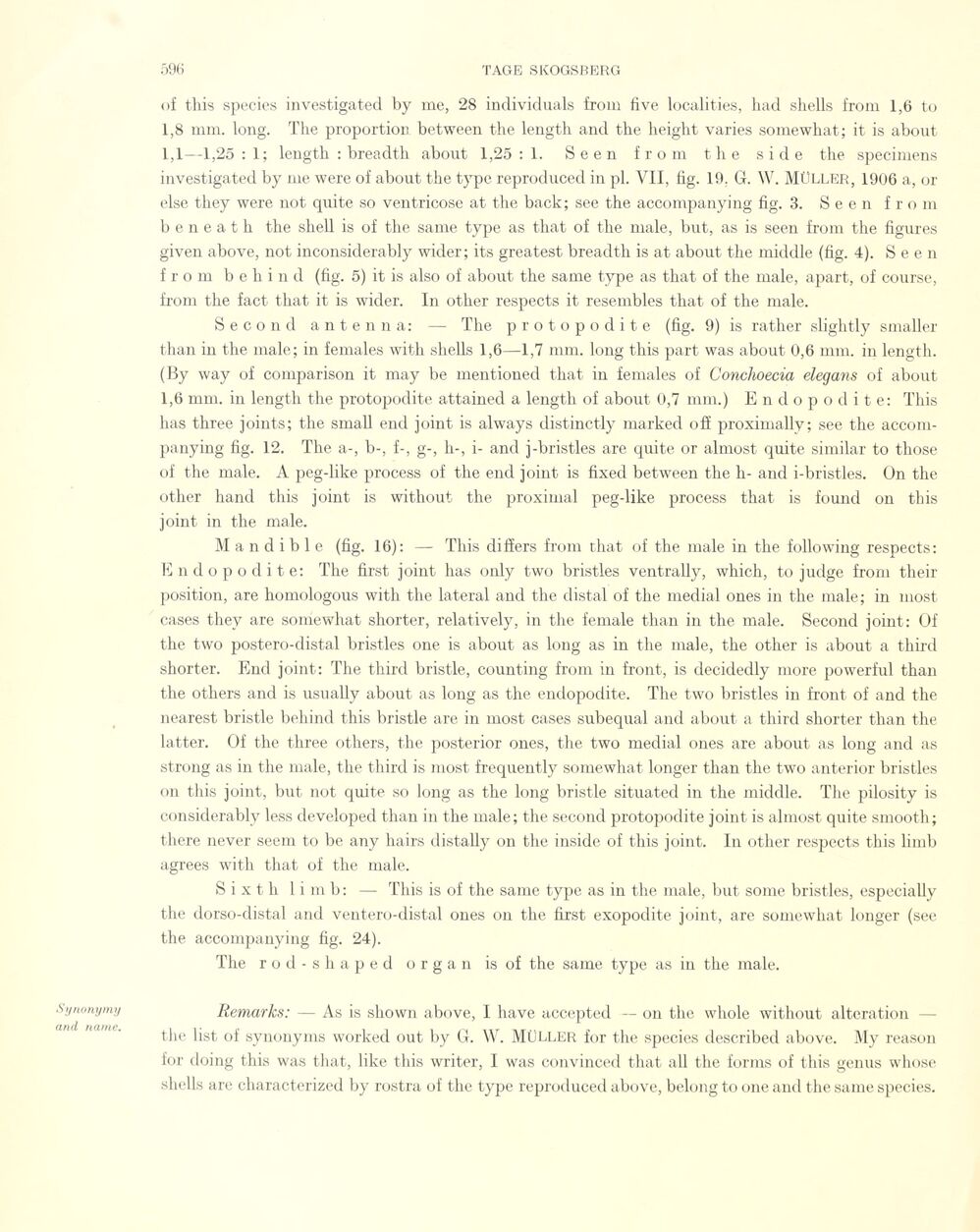
Full resolution (JPEG) - On this page / på denna sida - Sidor ...

<< prev. page << föreg. sida << >> nästa sida >> next page >>
Below is the raw OCR text
from the above scanned image.
Do you see an error? Proofread the page now!
Här nedan syns maskintolkade texten från faksimilbilden ovan.
Ser du något fel? Korrekturläs sidan nu!
This page has never been proofread. / Denna sida har aldrig korrekturlästs.
Synonymt/
and name.
of this species investigated by me, 28 individuals from five localities, had shells from 1,6 to
1,8 mm. long. The proportion between the length and the height varies somewhat; it is about
1,1—1,25:1; length : breadth about 1,25:1. Seen from the side the specimens
investigated by me were of about the type reproduced in pi. VII, fig. 19. G. W. Müller, 1906 a, or
else they were not quite so ventricose at the back; see the accompanying fig. 3. Seen from
b e n e a t h the shell is of the same type as that of the male, but, as is seen from the figures
given above, not inconsiderably wider; its greatest breadth is at about the middle (fig. 4). See n
from behind (fig. 5) it is also of about the same type as that of the male, apart, of course,
from the faet that it is wider. In other respects it resembles that of the male.
Second antenna: — The protopodite (fig. 9) is rather slightly smaller
than in the male; in females with shells 1,6—1,7 mm. long this part was about 0,6 mm. in length.
(By way of comparison it may be mentioned that in fe males of Conchoecia elegans of about
1,6 mm. in length the protopodite attained a length of about 0,7 mm.) Endopodite: This
has three joints; the small end joint is always distinetly marked o ff proximally; see the
accompanying fig. 12. The a-, b-, f-, g-, h-, i- and j-bristles are quite or almost quite similar to those
of the male. A peg-like process of the end joint is fixed between the h- and i-bristles. On the
other hånd this joint is without the proximal peg-like process that is found on this
joint in the male.
M a n d i b 1 e (fig. 16): — This differs from that of the male in the folio wing respects:
Endopodite: The first joint has only two bristles ventrally, which, to judge from their
position, are homologous with the lateral and the distal of the medial ones in the male; in most
cases they are somewhat shorter, relatively, in the female than in the male. Second joint: Of
the two postero-distal bristles one is about as long as in the male, the other is about a third
shorter. End joint: The third bristle, counting from in front, is decidedly more powerful than
the others and is usually about as long as the endopodite. The two bristles in front of and the
nearest bristle behind this bristle are in most cases subequal and about a third shorter than the
latter. Of the three others, the posterior ones, the two medial ones are about as long and as
strong as in the male, the third is most frequently somewhat longer than the two anterior bristles
on this joint, but not quite so long as the long bristle situated in the middle. The pilosity is
considerably less developed than in the male; the second pro topodite joint is almost quite smooth;
there never seem to be any hairs distally on the inside of this joint. In other respects this limb
agrees with that of the male.
Sixth limb: —- This is of the same type as in the male, but some bristles, especially
the dorso-distal and ventero-distal ones on the first exopodite joint, are somewhat longer (see
the accompanying fig. 24).
The rod-s haped organ is of the same type as in the male.
Remarks: — As is shown above, I have accepted — on the whole without alteration
-the list of synonyms worked out by G. W. MÜLLER for the species described above. My reason
for doing this was that, like this writer, I was convinced that all the forms of this genus whose
shells are characterized by rostra of the type reproduced above, belong to one and the same species.
<< prev. page << föreg. sida << >> nästa sida >> next page >>